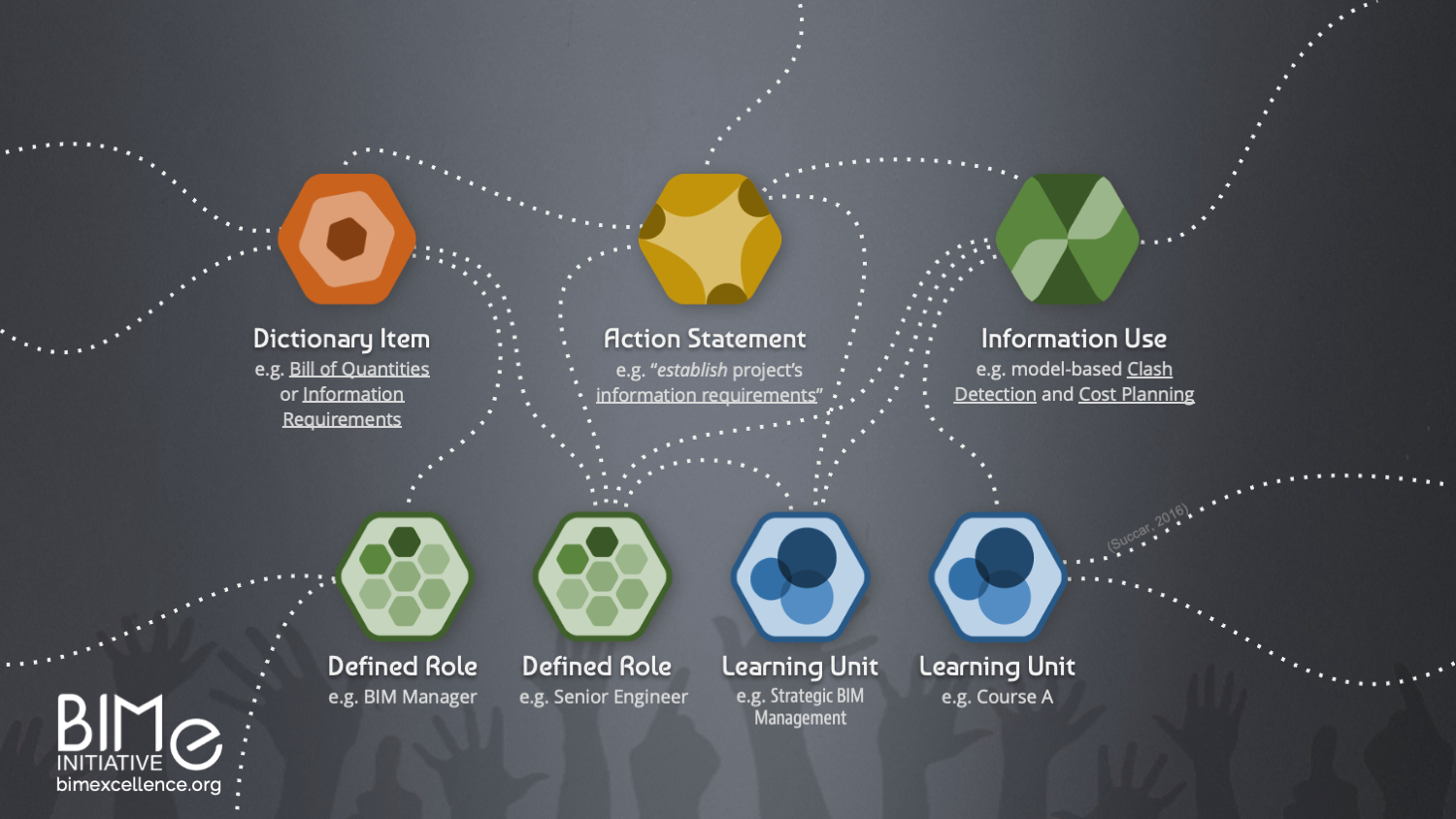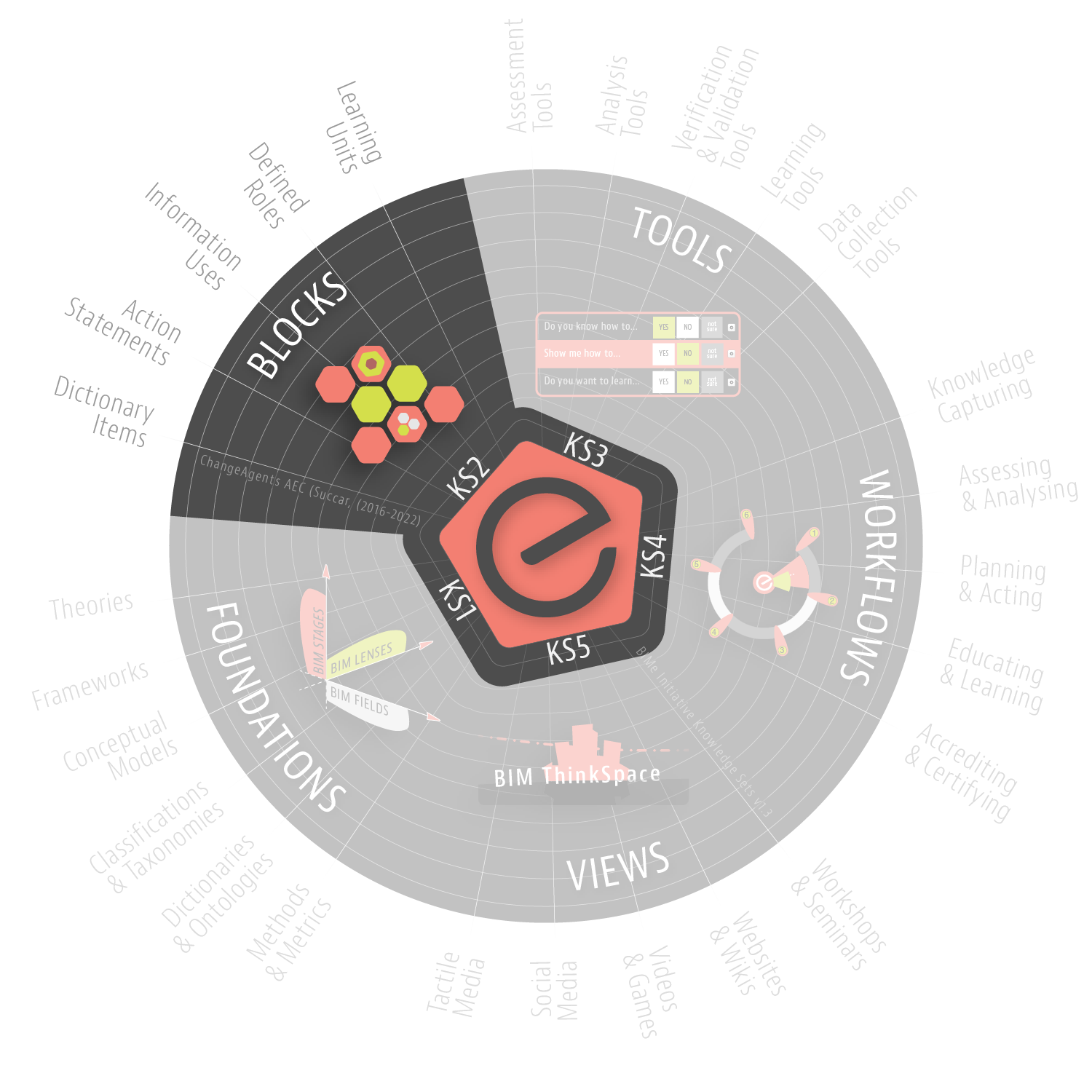Published on September 15, 2025 | Last Updated on September 24, 2025
Knowledge Blocks
Knowledge Blocks are self-contained, measurable units of Structured Information that can be easily combined to clarify requirements, simplify complex processes, and facilitate communication across the built environment sector. They form the foundation for BIMe Initiative tools, assessments, learning materials, and workflows.
Knowledge Blocks are modular by design and can be assembled into larger structures such as task lists, role definitions, and project templates to support performance assessment, learning, and process optimisation.

Knowledge Blocks are designed to be flexibly combined into larger structures, forming the foundation for performance assessment, process optimisation, and learning across projects and organisations.
Types of Knowledge Blocks
The current set of Knowledge Blocks includes:
- Dictionary Items: the terms and their definitions, translations and localisations that ensure clarity and shared understanding.
Example: “Federated Model” is defined as a coordinated but non-merged combination of separate discipline models.
- Action Statements (also known as Competency Items): the structured sentences describing measurable abilities, activities, or outcomes that can be assessed, learned, or applied.
Example: "Extract total rentable floor areas from a BIModel"
-
Information Uses: the intended or expected project deliverables generated from models, documents, or datasets. Information Uses fall into three categories:
- Model Uses: Deliverables based on 3D models (e.g. Clash Detection, Quantity Take-off)
- Document Uses: Deliverables based on documents (e.g. Specifications, Reports)
- Data Uses: Deliverables based on data sets or scripts (e.g. Energy Simulation, Automation Scripts)
Example: an Information Use would combine the 3020 Construction Planning (Domain Model Use) with "25 Construction Sequencing Scripting" (Domain Data Use) to simulate realtime construction progress, and generate a "607.1 Construction Status Report" (Custom Document Use). -
Learning Units: the structured clusters of learning objectives packaged for education, training, or professional development. Learning Unit support competence development and formal or informal learning.
Example: A Learning Unit covering "Introduction to Model-based Coordination" would include many relevant Action Statements, examples and assessments. - Defined Roles: a container for clearly delineated responsibilities or functions assigned to individuals operating within project environments or across whole markets.
Examples: "BIM Manager", "Senior Architect", and "Urban Planner" are roles that can be define using a combination of Competency Profiles, mapper to Action Statements, Information Uses and Dictionary Items.
Modular Language
Knowledge Blocks form the backbone of BIMe Initiative tools and processes by:
- Facilitating Communication by creating a shared language that bridges communication gaps between project participants, organisations, and software systems.
Example: A project team using the same Dictionary Items and Action Statements ensures consistent understanding of requirements across disciplines.
- Populating Knowledge Tools such as:
- Assessment Modules (e.g. capability self-assessments)
- Learning Modules (e.g. BIM training materials)
- Implementation Modules (e.g. project checklists, workflows)
Examples: the BIMdictionary.com tool is composed of hundreds of Dictionary Items and the assessor.io platform relies on hundreds on Action Statements to provide structure to its assessments. -
Reducing Complexity and Enabling Process Automation by assembling Knowledge Blocks into structured templates or workflows, complex tasks are simplified, and repetitive processes can be automated.
Example: A Model Use Template for "Clash Detection" combines Dictionary Items, Action Statements, and resource lists into a clear guide for project delivery. See example here. - Supporting Performance Improvement by allowing consistent benchmarking, gap analysis, and competency development.
Example: An individual's knowledge of "Clash Detection" can be assessed using related Action Statements, identifying learning needs or areas for improvement.
Knowledge Blocks within the BIMe Knowledge Structure

Knowledge Blocks (KS2) sit within the five-part BIMe Knowledge Structure:
KS1: Knowledge Foundations - Research, models, and classifications
KS2: Knowledge Blocks - Modular, structured language
KS3: Knowledge Tools - Practical guides, templates, assessments
KS4: Knowledge Workflows - Repeatable, structured processes
KS5: Knowledge Views - Ways to communicate and share outputs
Knowledge Blocks are part of the conceptual BIM Ontology and - when used in combination - form a modular language that facilitate communication between industry stakeholders, between people and systems – referred to as Human-computer Interaction (HCI), reduce process complexity, and facilitate process automation.
For more information, please refer to 102in BIMe Initiative Knowledge Structures.
